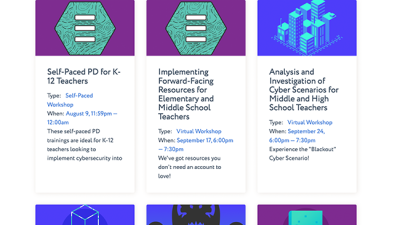In this month’s webinar, we heard from three guests with insights on how to connect with military students and set them up for success.
Here are the top 3 takeaways from our chat. Watch the full recording below!
1. Get to Know your Military Liaison
Raquel Labadie serves as the School Liaison Specialist with Child and Youth Education Services at Minot Air Force Base, North Dakota. She described her role as having 3 major components: Working with the command, working with families, and working with schools and educators. She said, “I work with the command to inform them about things that are happening in the school district and things that are affecting our military students.” Raquel ensures that families feel a smooth transition between school districts by coordinating credit transfers and welcoming students into their new school homes. Finally, she works to keep educators up to date on what military students may be facing both in and outside of school. She noted, “our military students are commonly separated from family and often that comes in the form of deployment. So as educators of our military students understanding deployment and the deployment cycle is important for them[…] there's anticipation and worry prior to a parent leaving."
If you're starting from square one in addressing the unique circumstances in which military students find themselves, your military liaison should be your first stop. They'll be able to act as a conduit between student, school, and military base.
Find your military liaison and other helpful resources at: https://www.militaryonesource.mil/education-employment/
2. Communication is Key
Dr. Frederick Rivers is the Principal of Meade Senior High School in Fort Meade, Maryland – home to Fort George G. Meade U.S. Army Post and agencies such as National Security Agency, Central Security Service, United States Cyber Command, and the Defense Information Systems Agency.
Meade Senior High School sees a large number of military-connected students continually moving through its diverse student population. He and his staff work hard to integrate the students with military backgrounds into Meade Senior High as smoothly as possible. “We're just one big happy community – the Mustang Nation! […] They get a chance to play in all the different sports activities that we have, and so, whether they live on base, or they live off base and attend the school, we still take care of them. We support them.”
"Whether they live on base, or they live off base and attend the school, we still take care of them. We support them.”
When asked how to best prepare for incoming military students, Dr. Rivers advised “communicate.” He went on, “We're engaged and we try to communicate that out directly to our parents and to our communities. Sometimes we even go behind that to make sure that we're covering our bases. We use the website a lot, we use Twitter a lot,[…] Record a voice message and send it out to the families with a text message.”
By communicating through the school liaison specialist and even looping in the counseling department during a student’s transition in as well as during the school year, Meade Senior High School works to create a supportive, attentive learning environment for military students.
3. Consider a Maker Space
James Wang, founder of mLAB, suggests creating a maker space and inviting military-connected students to join. “Because the community is so tight knit the need is somewhat more pronounced, and there are a lot of assets on air force bases, which is what we focus on that contribute to the maker space mission.”
In the mLAB location near Edwards AFB, tools such as 3-D printers and laser cutters encourage students to explore new skills like coding, engineering design, and creative thinking. He mentioned that even more than the growth in technical skills, military students seemed to gain an intangible benefit from the mLAB space.
“Maybe the most profound outcome of this […] is that a lot of the students felt that the maker space became a home away from home. They had a new tight knit student community where they could come after school hang out and learn things in the meantime.”



